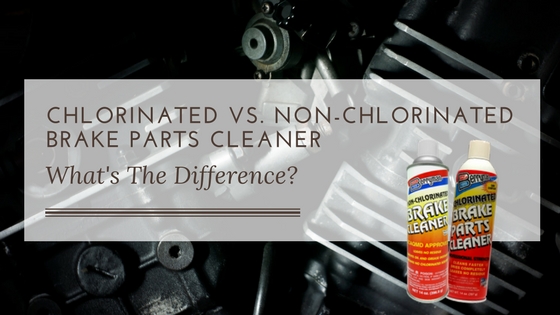Ever been shopping for brake fluid and wonder what are the pros and cons between using chlorinated vs. non-chlorinated products? While the main difference may seem obvious, the presence of chlorine, the idea that non-chlorinated versions are always ‘better for the environment’ may be deceiving.
Chlorinated Brake Cleaner
Chlorinated brake cleaner is the more commonly-used variety and it has been around the longest, despite the fact that many of the main ingredients are now banned for use in other applications. The term ‘chlorinated’ simply means that it contains chlorinated atoms, or solvents, within its molecular structure. These chemicals boost the solvent properties of the product. The problem is that some municipalities and state regulations have caused the ban of the use and sale of the chlorinated version (i.e. California).
Berryman Chlorinated Brake Parts Cleaner is made of the chlorinated solvents perchloro-ethylene (a.k.a. tetrachloroethylene) and methylene chloride. These are non-flammable solvents that are extremely fast-drying and provide the best cleaning for brake parts.
Non-Chlorinated Brake Cleaner
The non-chlorinated version of brake cleaner simply means that it doesn’t have chlorinated solvents in its molecular structure. However, this does not make it safe or ‘environmentally friendly.’ Often times, the alternative chemicals used in this variety of product are just as toxic, if not more so. These versions are not always as fast-drying as the chlorinated, and the solvents are flammable.
FACTOID: Perchloroethylene is the same solvent used for years as dry cleaning fluid. Many chlorinated brake cleaners are made up entirely of this component, occasionally with other heavy solvents to add weight. Methylene chloride is a primary component of paint stripper and is lighter. The combination of the two makes for a superior blend that provides more actual fluid content in the container for the weight versus perchloroethylene alone. Methylene chloride also has more caloric energy for dissolving grease, oil and other contaminants that are found on brake parts.
So, Which Do You Buy?
Before choosing a product, look closely to make sure you are getting the one best suited for your needs.
If you are cleaning a metal part that you plan on welding, using brake cleaning products is not recommended as it may create toxic fumes when welded (chlorinated versions in particular). Non-chlorinated brake cleaners are also safer to use on plastic parts.
It is important to remember that many brake cleaner products are also not compliant in all 50 states. So, before buying any brake cleaner, look closely to ensure you are getting the one best suited for your needs and is compliant in the area you will be using it.
Whether you prefer a chlorinated or non-chlorinated product, Berryman offers exceptional options for both. Our products quickly and effortlessly dissolve brake fluid, dust, grease, motor oil, power steering fluid, and other contaminants you find on metal brake parts. They are great to use on all brake parts, including rotors, drums, calipers, cylinders, springs, and other related parts. Our professional-strength formula dries quickly and completely, without residue.
We also offer an excellent engine degreaser that is great for cleaning all kinds of engine parts. It contains our proprietary blend of high-performance detergents and emulsifiers that easily penetrate road grime, dirt, grease, and oil. It’s fast spray on/rinse off cycle saves time and conserves water. This product is designed for vehicle engines, small engine parts, lawn mowers, hand tools, machinery, fleet, farm, and marine equipment.
Have any questions? Feel free to contact us here, or ask a question in our solution center. We look forward to hearing from you!

